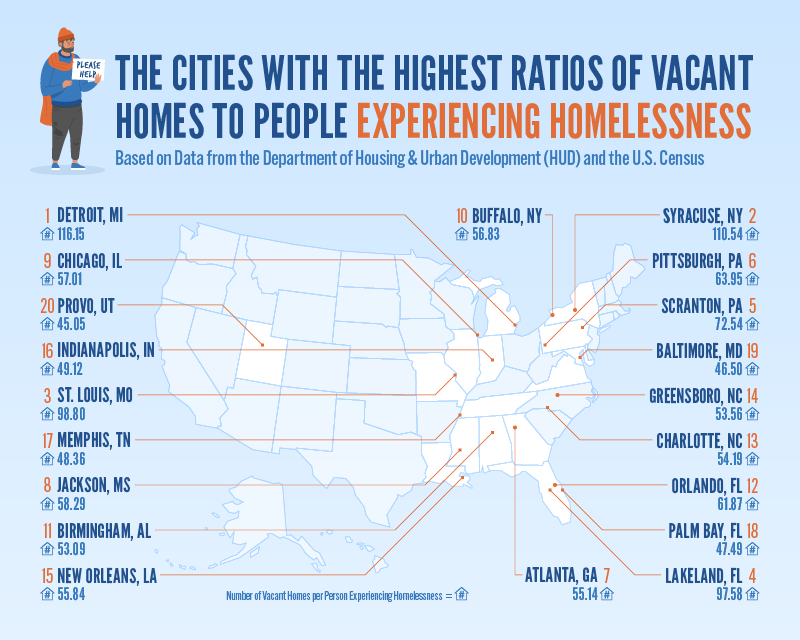
For many Americans, finding affordable housing continues to be a challenge, whether you’re renting or buying. In today’s real estate market, many overpriced homes sit vacant while populations experiencing homelessness continue to grow. In this study, we took a closer look at data from the U.S. Census and the Department of Housing & Urban Development (HUD) to compare the number of people experiencing homelessness to the number of vacant housing units in 100 major cities across the country. Continue reading to learn more about which cities have the highest risk of homelessness in America.
Homeless or Unhoused? Which Term is Preferred & Why
While both terms, “homeless” and “unhoused,” are used interchangeably, the preference often lies with “unhoused” as it emphasizes the temporary circumstance rather than defining an individual by their lack of shelter. It seeks to humanize the situation and underscore the systemic issues contributing to housing instability, fostering a more compassionate and respectful discourse. Ultimately, the choice of terminology can vary among individuals and communities, but the aim remains to address the issue with empathy and understanding.
Key Findings
- Despite how many houses are in the US, over 580,000 Americans are experiencing homelessness. There are currently 28 vacant homes for every one person experiencing homelessness in the U.S.
- While cities like New York City, Los Angeles and Seattle have some of the largest unhoused populations in the country, Detroit has the most vacant homes per unhoused person–116 empty homes per unhoused person.
- Syracuse, New York has the second-most vacant homes per unhoused person–110 vacant homes per unhoused person.
- San Jose, California has the highest population of Gen-Z youth experiencing homelessness with nearly 85 unhoused Gen-Zers for every 100,000 residents.
- Pacific Islander and Black Americans are the populations most at risk to experience homelessness.
Analyzing the Number of Vacant Houses Per Unhoused Person by US City
Sixteen million homes currently sit vacant across the U.S. Despite how many houses are in the U.S., millions remain empty across the country while hundreds of thousands of Americans face homelessness. Vacant homes and buildings often succumb to the elements and deteriorate due to leaks, damage and general lack of maintenance before ever finding a buyer willing to pay their inflated prices. An abundance of vacant homes on the market are also attributed to rising rent and home prices.
While cities like New York City, Los Angeles and Seattle have some of the largest unhoused populations in the country, Detroit has the most vacant homes per unhoused person–116 empty homes per unhoused person. This is a sobering insight given there are four to five vacant homes per unhoused person in cities like Oakland, California and Portland, Oregon. This disparity is not unique to Detroit, as many cities across the U.S. have a significant number of vacant homes while also struggling with homelessness.
Just a few hours from the Big Apple, Syracuse, New York has the second-most vacant homes per unhoused person–110 vacant properties per unhoused person. In the Syracuse metro area, over 68,000 homes are either uninhabited or on the market, but not yet sold or rented, according to the U.S. Census.
In the Midwest, there are over 50 vacant houses per unhoused person in Chicago, Illinois. Chicago has a total of 307,284 vacant homes, an increase of nearly 22,500 homes since the 2010 Census was conducted. Nearly 10% of roughly 3,000,000 homes in Chicago remain vacant as the unhoused population continues to grow.
Cities With the Most Unhoused Young Adults
Hover over each plot point to find the number of youths without a house, 18 to 24 years old and under 18, in each US city.
San Jose, California has the highest population of unhoused Gen-Z youth (aged 18 to 24) in the country, with nearly 85 unhoused Gen-Zers for every 100,000 residents. San Jose has nearly 50 more persons experiencing homelessness aged 18 to 24 than the second-highest city on the list, New York City, highlighting the need for more effective solutions to address youth homelessness in this area, particularly for young people of color.
New York, Los Angeles, Honolulu and Seattle round out the top five cities for unhoused Gen-Zers per 100,000 residents.
The State of Homelessness and Housing Availability in the US
To round out our study, we took a deep dive into the current state of homelessness in the U.S. using HUD data. Here’s what we found:
- Over 580,000 people currently experience homelessness in the U.S. and the unhoused population grew by nearly 5% between 2018 and 2020.
- The three U.S. cities with the largest unhoused populations include New York City (78,000), Los Angeles (64,000) and Seattle (12,000).
- The populations at greatest risk of homelessness are Pacific Islander and Black communities.
The white population is the largest in the U.S. with the largest unhoused population (280,612 homeless), but when we position each race’s population experiencing homelessness against their overall population, we can see that the Pacific Islander and Black communities are the racial groups hit hardest by homelessness.
Explore the Full Housing Data
Interested in diving deeper into the number of houses in America vs the number of homeless, or wanting to see how your city stacks up? We’ve compiled our full data study for all 100 U.S. cities analyzed into the interactive data table below. Search for the city you call home or click on the heading of each column to sort by that category.
Possible solutions to fight the disparity between the two include increasing funding for affordable housing and homeless services, implementing policies that address discrimination and systemic barriers, and finding innovative solutions to repurpose vacant homes to provide housing for those in need. Read an impact story about a community member struggling with being unhoused and how assistance programs were able to support them.
United Way NCA’s ALICE Lives Here initiative addresses the issues of inequity related to housing in addition to employment, education, health, food access and financial stability in the National Capital Area. The program aims to raise awareness about the everyday struggles faced by households above the Federal Poverty Line who still cannot afford necessities such as housing, food, health care and child care. The goal of the initiative is to make the National Capital Area a better place to live for all residents by addressing these issues and working toward a more equitable community.
United Way NCA also hosts Project Community Connect, an outreach program in the DC area that aims to connect ALICE community members with essential services through resource fairs and street outreach. Its goal is to achieve equity for all of our community members, regardless of race, gender, income and ability.
Our Methodology for Analyzing Housing Data
To determine the number of vacant homes per unhoused person in 100 of America’s largest cities, we pulled the most updated number of people experiencing homelessness in each city from the Department of Housing and Urban Development and the number of vacant housing units in each city from the U.S. Census’s American Community Survey. We then divided the number of vacant units by the number of unhoused people in each city to find the number of vacant homes per person experiencing homelessness. We found all homelessness statistics by race, age and geography using data from the Department of Housing and Urban Development.
FAQs about Housing Availability and Homelessness in the US
How many single-family homes are there in America?
A 2021 study showed that the majority of occupied homes in the US (around 82 million) are single-family houses. This means that detached houses are the most common type of housing in the country. (Source: Statista)
How much housing is there in the US?
According to the U.S. Census Bureau, the total number of housing units in the United States, including both occupied and vacant properties, reached 145,344,636 as of July 1, 2023. (Source: U.S. Census Bureau)
How many homes in the US are occupied?
Based on data from 2021, approximately 129 million housing units in the US are occupied (Source: Statista). This includes various types of housing, from single-family homes to apartments. The owner-occupied housing unit rate was 64.8% between 2018 and 2022 (Source: U.S. Census Bureau).
How many people in the US are experiencing unsheltered homelessness?
In 2023, a record 256,610 people, or 39.3% of the homeless population, were unsheltered, facing significant challenges and risks associated with living without stable housing. (Source: endhomelessness.org)
Is there a link between housing costs and homelessness?
Yes, the number of renter households spending over 50% of their income on rent increased by 12.6% from 2015 to 2022. This severe housing cost burden is a major contributor to homelessness. (Source: endhomelessness.org)
Recent Posts
blog



